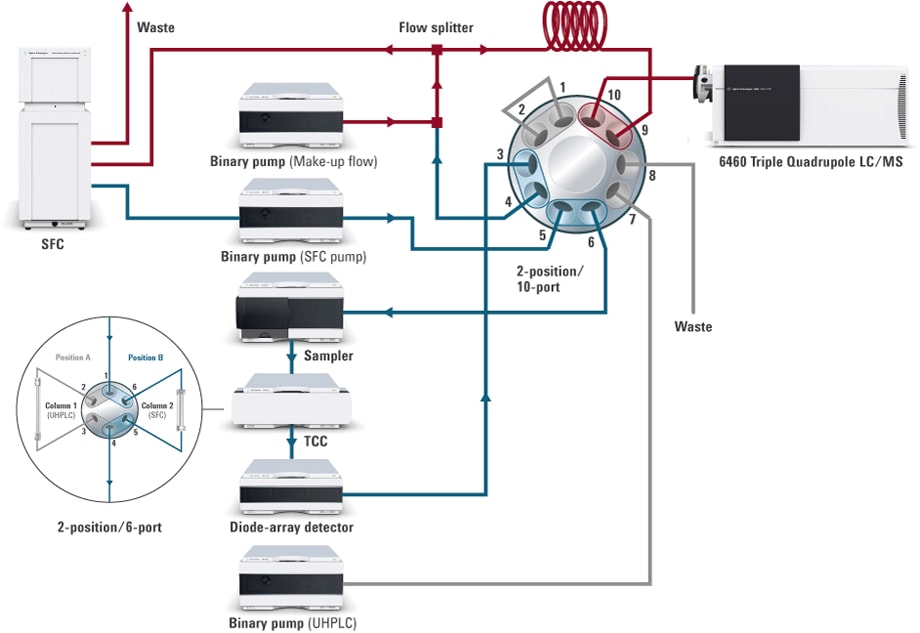Access Agilent eNewsletter August 2015
>> Update My Profile | Subscribe to Access Agilent | Article Directory

Fast, accurate achiral and chiral metabolite profiling using the Agilent SFC/UHPLC hybrid system with triple quadrupole MS detection
By Siji Joseph
Agilent Application Scientist
Metabolite profiling using LC/MS is often made more challenging due to formation of stereo and regio-specific isomers of metabolites. Peak to peak chromatographic separation of individual isomers is a preferable strategy for more confident achiral and chiral analysis of these trace level metabolites using mass spectrometry. However, reverse-phase High Performance Liquid Chromatography (HPLC) is the most preferred separation method for achiral analysis. Supercritical Fluid Chromatography (SFC) also enables fast separations with several advantages over other conventional normal phase separations for achiral or chiral analysis. To maximize these approaches, the Agilent 1260 Infinity Analytical Hybrid SFC/UHPLC System offers seamless method switching between SFC and RPLC modes.
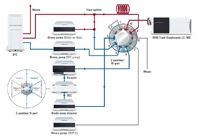 Enlarge
Enlarge
Figure 1. Schematic instrument diagram of Agilent 1260 Hybrid SFC/UHPLC system.
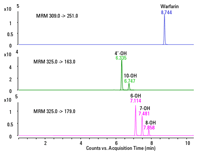 Enlarge
Enlarge
Figure 2. Achiral separation using RPLC using Agilent ZORBAX Eclipse Plus Phenyl Hexyl (2.1 x 150 mm, 1.8 µm) column (MRM Transition of metabolites are shown).
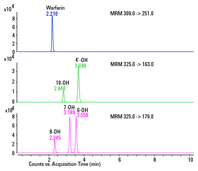 Enlarge
Enlarge
Figure 3. Achiral SFC separation using a Zorbax RX-SIL (4.6 x 150 mm, 5 µm) column (MRM transition of metabolites are shown).
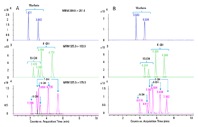 Enlarge
Enlarge
Figure 4. (A) Chiral SFC separation of 100 ng/mL standard mix using a CHIRALPAK OD-3 (3.0 x100 mm, 3 µm) column. Isomers of each metabolite are marked. (B) Improved chiral SFC separation of the standard mix, when a Zorbax RX-SIL column was serially connected with a CHIRALPAK OD-3 column. The separation of 6-, 7- and 8-hydroxy warfarin isomers was significantly improved when the Zorbax A was serially connected with a CHIRALPAK OD-3 column. MRM transitions for all metabolites and warfarin are labeled.
In the following example, we describe achiral and chiral profiling of stereo and regio-isomers of warfarin oxidative metabolites using an Agilent 1260 Infinity Analytical Hybrid SFC/UHPLC coupled with Agilent 6460 QQQ system. Using the system in RPLC mode, achiral separation of warfarin and its five hydroxylated metabolites was performed. Then, while in SFC mode both chiral and achiral separations were performed. Agilent 6460 QQQ ensured detection of all hydroxywarfarin isomers at sub nano molar sensitivity.
Automated method switching and enhanced sensitivity with Agilent solutions
The automated method switching between RPLC and SFC is made possible by including a 2 position/10 port valve which is controlled by Agilent MassHunter software without any manual hardware reconfiguration. The schematic instrument diagram is shown in Figure 1. The thermostatted column compartment was equipped with an additional 2-position/6-port column switching valve to enable the easy selection of the appropriate column for each mode. Enhanced ionization was achieved by including an additional binary pump in the instrument configuration for a make-up flow. A flow splitter was also installed prior to injecting the sample in QQQ, by which one part of the column flow was directed to QQQ and the other part to the backpressure regulator (BPR) of the SFC module. As a result, peak broadening through BPR was avoided. The analytes from the RPLC and SFC separations were detected using an Agilent 6460 Triple Quadrupole mass spectrometer. The electrospray source was equipped with Agilent Jet Stream (AJS) thermal gradient focusing technology to enhance sensitivity and was operated in positive mode. Protonated [M+H]+ ions of warfarin and metabolites were selected as precursors for MRM acquisition.
Excellent achiral reverse-phase separation with Agilent ZORBAX column
In this test, we used a hybrid SFC/UHPLC-QQQ system in RPLC mode, and achiral reverse-phase analysis was performed initially with narrow bore phenyl hexyl column. Excellent base line separation of warfarin and all five hydroxylated metabolites were observed (Figure 2).
Clear achiral SFC separation with Agilent ZORBAX RX-SIL
The achiral SFC analysis using an Agilent Zorbax RX-SIL column resulted in a clear separation of warfarin and all five hydroxylated metabolites (Figure 3). The complimentary strategy of using RPLC and SFC analysis is evident from the reversal of elution order of warfarin and metabolites. SFC provides a faster analysis time compared to RPLC.
Chiral SFC separation optimized with serial connection of multi-vendor apparatus
Chiral SFC analysis using CHIRALPAK OD-3 column was able to separate enantiomers of all five regio- and stereo-isomers of hydroxyl warfarin. However, base line separation of few isomeric peaks was compromised. A serial connection of Agilent Zorbax RX-SIL and CHIRALPAK OD-3 columns gave better resolution of all five hydroxywarfarin regio-isomers as well as warfarin (Figure 4). The low column backpressure (< 260 bar) in SFC mode offers greater flexibility to couple multiple column chemistries and add orthogonality in the separation.
Seamless and flexible solution for chiral drug metabolism studies
Read the full story of the work described in this article in Agilent publication 5991-5725EN. Agilent offers a full line of LC, HPLC, and UHPLC solutions to match any application or budget. For example, the Agilent 1200 Infinity Series represents a comprehensive toolkit of leading-edge solutions that offer UHPLC capabilities at HPLC prices. What’s more, these solutions deliver outstanding sensitivity and are completely compatible with all of your HPLC methods. To discover more Agilent solutions that can assist you in your particular applications, contact an Agilent Representative today.
>> Update My Profile | Subscribe to Access Agilent | Article Directory
Figure 2.
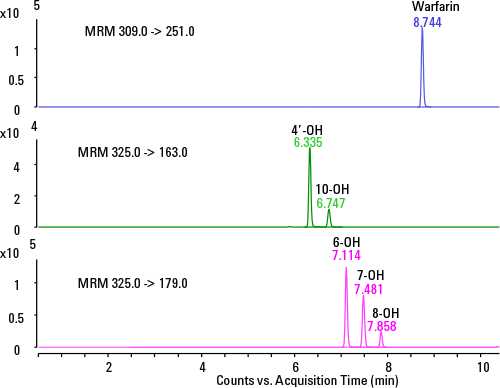
Achiral separation using RPLC using Agilent ZORBAX Eclipse Plus Phenyl Hexyl (2.1 x 150 mm, 1.8 µm) column (MRM Transition of metabolites are shown).
Figure 3.
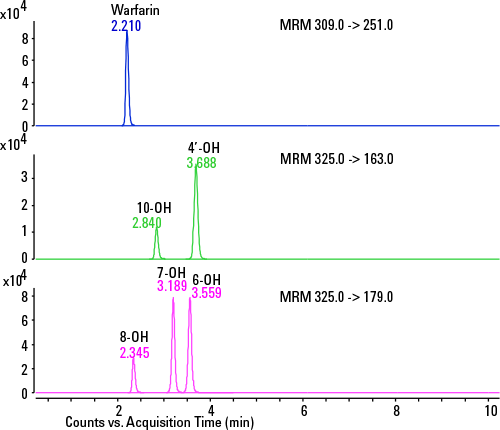
Achiral SFC separation using a Zorbax RX-SIL (4.6 x 150 mm, 5 µm) column (MRM transition of metabolites are shown).
Figure 4.
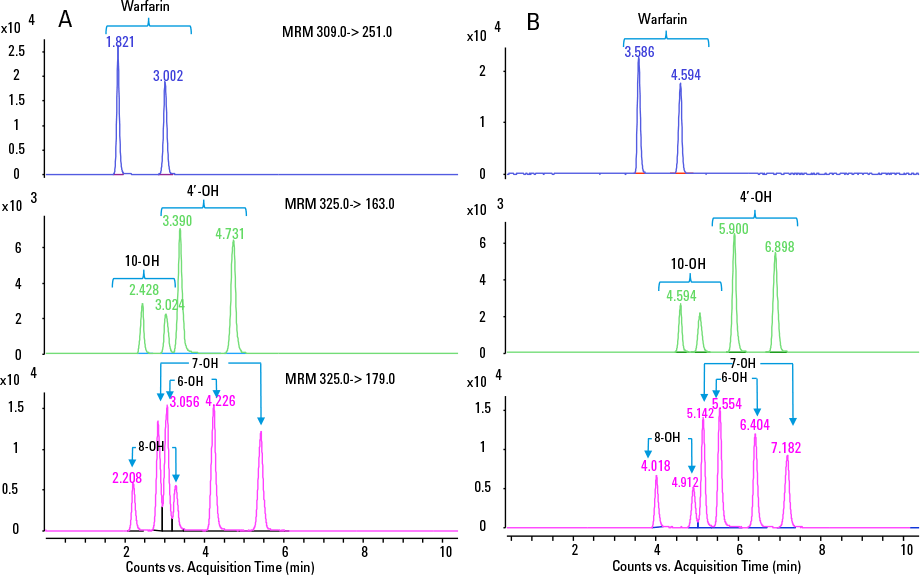
(A) Chiral SFC separation of 100 ng/mL standard mix using a CHIRALPAK OD-3 (3.0 x100 mm, 3 µm) column. Isomers of each metabolite are marked. (B) Improved chiral SFC separation of the standard mix, when a Zorbax RX-SIL column was serially connected with a CHIRALPAK OD-3 column. The separation of 6-, 7- and 8-hydroxy warfarin isomers was significantly improved when the Zorbax A was serially connected with a CHIRALPAK OD-3 column. MRM transitions for all metabolites and warfarin are labeled.
